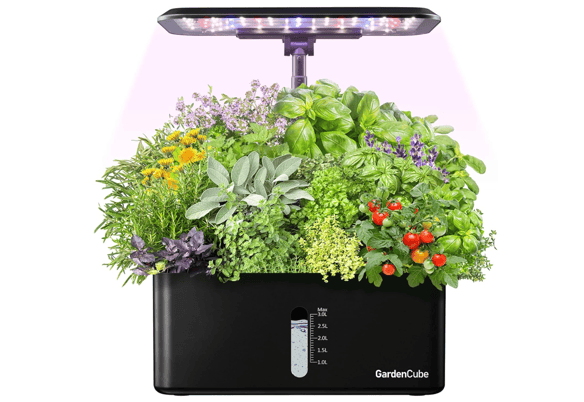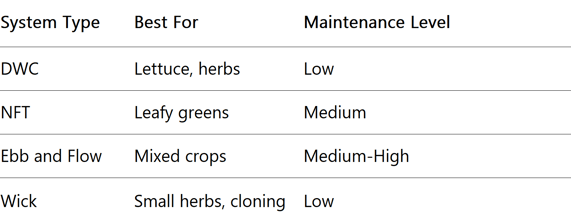Advantages Of Hydroponics Growing System (Indoor Garden), And How To Use It for Efficient Home Cultivation
4/26/20254 min read


Hydroponics growing systems allow people to grow fresh produce indoors without soil, giving greater control over plant health and resource use. This method uses water and nutrients directly delivered to plant roots, making it highly efficient and suitable for small spaces or urban living.
Many find that hydroponic indoor gardens require less water, reduce pest problems, and can speed up growth compared to traditional soil gardening. With the right setup, anyone can cultivate greens, herbs, and vegetables year-round, regardless of outdoor conditions.
Learning how to use a hydroponics system is straightforward and often requires only basic tools and supplies. These benefits make it an appealing choice for both beginners and experienced gardeners looking to maximize their harvest indoors.
Core Advantages Of Hydroponics Growing System Indoor Garden
Hydroponic systems provide growers with precise control over growing conditions, resulting in optimized plant health and resource use. Indoor gardens using hydroponics allow for continuous cultivation and can make urban or limited-space gardening more practical and efficient.
Year-Round Crop Production
A hydroponic indoor garden operates independently of outdoor weather. This means plants are unaffected by seasonal changes, temperature swings, or drought.
Growers can use artificial lighting and climate controls to maintain the ideal growing environment throughout the year. Daily light cycles, humidity, and temperature can all be adjusted to suit specific crops. This level of control allows for continuous planting and harvesting, regardless of external conditions.
Crops such as lettuce, herbs, and tomatoes can be available fresh every month. For those in regions with short growing seasons or harsh winters, hydroponics provides a reliable alternative for steady food production.
Efficient Use Of Water And Nutrients
Hydroponic systems use water much more efficiently than traditional soil gardening. Water is recirculated and delivered directly to plant roots, reducing losses through evaporation and runoff.
Nutrient solutions are precisely measured, allowing for targeted application based on each plant’s exact requirements. This minimizes waste and helps avoid issues like nutrient leaching or over-fertilization.
According to agricultural studies, hydroponic systems can use up to 90% less water compared to soil-based gardens. Resource efficiency helps lower utility costs and supports sustainable, environmentally conscious growing methods.
Faster Plant Growth And Higher Yields
Plants in hydroponic setups typically show accelerated growth cycles. Since their roots have direct access to oxygen and balanced nutrients, plants spend less energy searching for resources.
Environmental consistency further supports robust growth. Unlike soil gardens, there’s less exposure to pests, diseases, or unpredictable variables. With these supports in place, plants often mature faster and produce more per harvest.
For example, hydroponic lettuce may reach maturity in about half the time needed in soil. Growers can achieve multiple crop cycles per year and take advantage of higher planting densities in limited indoor spaces.
How To Use An Indoor Hydroponics Growing System
Successful indoor hydroponics relies on choosing the right system for your plants and establishing a controlled environment for healthy growth. Factors such as available space, plant type, lighting, and climate control can each influence long-term results.
Selecting The Right Hydroponic System
There are several main types of hydroponic systems, including Deep Water Culture (DWC), Nutrient Film Technique (NFT), Ebb and Flow (Flood and Drain), and Wick systems. Each design has unique strengths suited to different plant varieties and user preferences.
For beginners, DWC and Wick systems are popular due to their simpler setups and lower maintenance needs. Growers seeking to maximize yields with leafy greens often choose NFT, while the Ebb and Flow method is adaptable for a wider range of crops.
Table: Common System Types and Best Uses
When selecting a system, it is important to consider available space, power supply, and water access. Reviewing the technical support offered by manufacturers can be helpful, especially for beginners or complex models.
Setting Up Your Indoor Garden Environment
The environment for a hydroponics system requires direct control over light, temperature, humidity, and airflow. LED grow lights are commonly used because they provide adequate light without excessive heat and are energy efficient.
Maintain temperatures between 65°F and 75°F (18°C to 24°C) for most vegetables. Humidity should generally be kept between 50% and 70%. Use fans to ensure air circulation and prevent mold or mildew.
Set up an automatic timer for lights to ensure plants receive consistent photoperiods. It is also important to monitor and adjust pH and nutrient concentrations regularly by using meters designed for hydroponic systems.
Organize all tools and supplies nearby. Reserve space for a water reservoir and ensure easy access for cleaning and refilling. Proper setup helps reduce plant stress and maximizes growth potential.
Additional Benefits And Considerations
Hydroponic indoor gardens offer targeted benefits in areas such as space use, hygiene, and the use of additives. Their setup is often more controlled and customizable than conventional soil-based gardening.
Minimal Space Requirements
Hydroponic systems are well-suited for locations with limited room. They can be stacked vertically or fitted in unused corners, efficiently maximizing every square foot. Many people successfully grow crops in apartments, garages, and small rooms because plants do not spread their roots as widely as in soil.
A comparison highlights this advantage:
Soil Bed Growing Method : 2–3 square feet per plant typically needed
Hydroponics Growing Method: 0.5–1 square foot per plant typically needed
By circulating nutrient solutions and supporting plants directly, hydroponics eliminates the need for large soil containers or beds. This flexibility makes it possible to maintain a high yield even in tight urban spaces or shared environments.
Pest And Disease Control
Hydroponic gardens face fewer issues with soil-borne pests and diseases. Since there is no soil to harbor pathogens, common problems like root rot, soil fungi, and nematodes are significantly reduced. Plants are grown in a sterilized medium or directly in water, reducing the risk of infestations.
It is easier to monitor and manage the system’s environment, including humidity and temperature. As a result, the spread of mold, mildew, and harmful insects can be kept to a minimum. Quick identification and targeted intervention are possible because the closed system allows for daily inspection and adjustment.
Reduced Need For Chemical Inputs
Without exposure to unregulated outside elements, hydroponic systems generally require fewer pesticides and herbicides. The controlled environment and absence of soil mean that weeds do not grow, and insect invasions are easier to prevent or detect early. This allows growers to use less chemical intervention compared to outdoor or traditional soil systems.
Nutrient delivery is precise, so plants receive only what is necessary, reducing excess fertilizer runoff. This not only minimizes chemical use but also lessens environmental impact. Growers often choose organic or minimal-input nutrient solutions for healthier produce.


Sustainability
Explore eco-friendly practices for a greener future.
Gardening
eyesforeco@gmail.com
© 2025. All rights reserved.
